REMEMBERING K. RAJAH
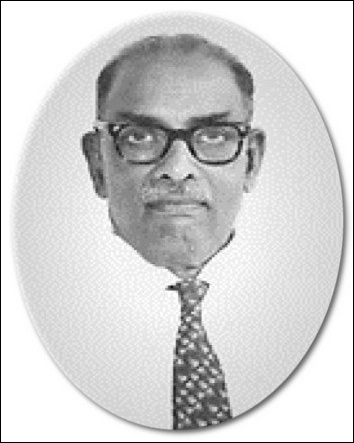
Rajah Kathiravelu
12 May 1898 to 20 December 1992
Profiled here is the story of Mr. Rajah Kathiravelu who demonstrated that age is no barrier when it comes to serving the Faith with youthful energy and zeal. Rajah had served in several capacities, belying his age, and has left traces that remain forever. Presented in this write up are selected anecdotes from his life, that characterized the unique roles he played during the very early days of the establishment of the Faith in Malaysia. K. Rajah as he was called shall forever be remembered as a truly legendary figure in the annals of our Faith.
Rajah worked as a State Treasurer with the Negeri Sembilan state government, holding the responsibility of managing funds and the budget of the state. As State Treasurer, he was highly respected as an honest and hardworking civil servant, whose mature guidance and insightful suggestions brought in much revenue to the state.
Rajah retired at the age of fifty-five in 1953. He was a longtime friend of Yankee Leong, who was the first enlightened soul to accept the Faith in Peninsula Malaya. As soon as Yankee Leong accepted the Faith on 19 December 1953, he took the Faith first to his closest friends in his hometown of Seremban, and that included Rajah. As soon as the Redeeming Message of Bahá’u’lláh was given to him, Rajah investigated the Faith seriously and spent time going into the roots of the teachings, especially the literature that Yankee Leong had given him. In the early days of investigating, Rajah, himself well-grounded in Hinduism would come with huge books on Hinduism and preach to Yankee Leong, who would listen patiently. After Rajah had spoken, it was the turn of Yankee Leong to speak on the Bahá’í Faith. In subsequent visits, Rajah came without the books on Hinduism, highly enthusiastic to listen to Yankee Leong. Soon Rajah was very convinced on the Mission and Message of Bahá’u’lláh. He then accepted the Faith with clarity of thought and as a convinced believer in 1954 at the age of fifty-six, just one year after his retirement.
The acceptance of the Faith by Rajah was not smooth sailing for someone who had risen so high in his career. Rough roads were awaiting from various quarters. Strong opposition came first in his own family, and then from the well-established Ceylonese community in the town of Seremban and from other towns in Malaya. The Ceylonese Tamil speaking community in Seremban had a very large presence, and Rajah grew up as one who was steeply rooted in the cultures and traditions of the Ceylonese Tamil community. It took nothing less than great courage and audacity for him to step out of that circle. Rajah was unshakable as a mountain in his faith in his new-found religion. To Rajah, the Faith seemed to have brought the longed-for light of eternal salvation into his life. His faith translated into formidable actions as he grew in the Faith. The fervor with which he moved and served the Cause at old age until ill health forced him to slow down in the late 1970s was itself remarkable.
Having accepted the Faith in 1954, Rajah was elected on the first Local Spiritual Assembly of Seremban in Ridván 1954, with Yankee Leong as Chairman and Rajah as Vice-Chairman. That was also the first Local Spiritual Assembly of Peninsula Malaya. Rajah would continue to serve on that institution for more than a decade. But the early years came as a great challenge to him. As soon as Yankee Leong accepted the Faith he began traveling to other places in Peninsula Malaya to teach the Cause to his other close friends. In his absence from Seremban town, it was left to Rajah to play the pivotal role of a fatherly figure in building up this community nascent community. Soon he was joined by Mr. Poh Eng Siew, a believer of financial means who worked closely with Rajah in promoting the Cause.
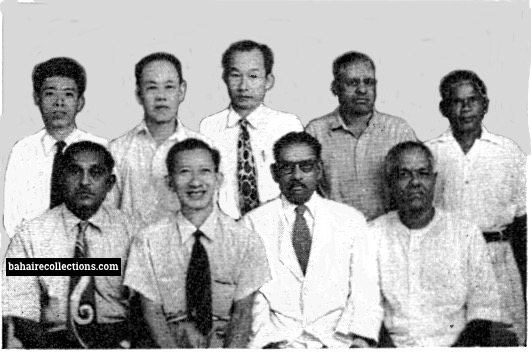
Second Local Spiritual Assembly of Seremban, 1955. Seated in the center are Yankee Leong (L) and K. Rajah (R). Standing at the extreme left is Johnnie Lee, son in law of Yankee Leong.
While Yankee Leong was creating waves outside Seremban, Rajah was equally doing his part in promoting the Cause in Seremban. As soon as he accepted the Faith he immediately took the Faith to all the organizations in which he held prominent positions. His involvement prior to accepting the Cause of Bahá’u’lláh was, among others, in the following organizations:
- Theosophical Society – Chairman
- Negeri Sembilan Government Servants’ Cooperative Society – Chairman
- Vivekananda Society – Vice-Chairman
- Consumer Society of Malaya – Director
- Jaffna Cooperative Society – Member
- Social Welfare Society of Malaya – Treasurer
- Young Men’s Hindu Association of Kuala Pilah – Founder
After taking the Faith to all these organizations, Rajah resigned from all these bodies to be fully committed to the Bahá’í Cause. It was a great surprise to the members of these well-established and prominent organizations that Rajah was giving up membership in his prestigious roles. They expected Rajah to continue leading and guiding them. However, as he had related to close friends, Rajah felt he did not have much time to spare as he had accepted the Faith rather late in his life and this sense of urgency propelled him to want to serve the Faith without any distractions.
Rajah was hungry for knowledge on the Faith. One of the main sources was visitors from abroad and Bahá’í gatherings held in the early days. Dr. Raḥmatu’lláh Muhájir had a great influence on him, starting with the first Bahá’í Summer School in December 1957 where Dr. Muhájir was present. There he had met several other strong pillars such as Dr. K. M. Fozdar, Shirin Fozdar, G. Saurajen, Lena Saurajen, Nong Chik, Mirinal Kanti Paul, Yankee Leong, Chin Chia Kwei, Leong Tat Chee, and Wong Kok Mee, who were among the cream in the Cause. Also present were Jeanne Frankel and her mother Mrs. Margaret Bates who just returned from their pioneering post in the Nicobar Islands. As soon as the Summer School classes came to a close at 10:30 pm on 29 December 1957, Dr. Muhájir convened a meeting that lasted until 12:30 am the following day to discuss on achieving the goals of the plan of the Regional Spiritual Assembly for Malaya. At this gathering, Rajah saw the importance to serve the needs of the Cause and stepped up his activities in Seremban.
The one other very moving period in his life was the Inter-Continental Conference held in Singapore from 27- 29 September 1958 where Rajah met the following Hands of the Cause of God: Leroy C. Ioas, Taráz’u’lláh Samandarí, Abu’l-Qásim Faizi, Harold Collis Featherstone, Dr. Raḥmatu’lláh Muhájir, Miss Agnes Alexander, Shu’á’u’lláh ‘Alá’í, Dr.`Alí-Muhammad Varqá and Enoch Olinga. Rajah as one of the participants gained so much knowledge and inspiration and returned with great enthusiasm and determination to offer his services for the Cause.
Rajah had a great knowledge of the Faith and contacted whoever had information on specific topics. Rajah contacted S. L. Thevar for details on Biblical prophecies and Thevar wrote a long reply dated 15 June 1960 to Rajah, in which he had quoted amply from the Bible on the proof of the fulfillment of the Biblical prophecies in the Bahá’í Faith.
Rajah was also one of the participants in the First Bahá’í World Congress held in London from 28 April to 2 May 1963 where he witnessed the gathering of some 6,000 believers from around the world. He met some Hands of the Cause and members of the first Universal House of Justice. Of the Congress, Rajah commented, “It was a unique gathering… a miracle without parallel.”
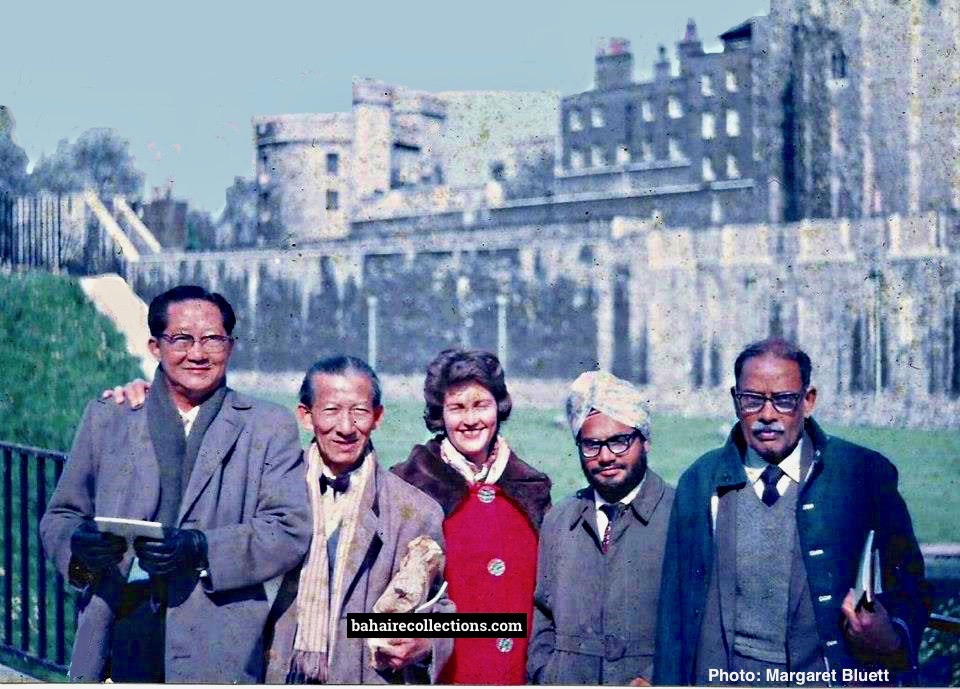
In London, while participating in the First Bahá’í World Congress, 1963. From L-R: Leong Tat Chee, Yankee Leong, Margaret Bluett, Sathiawan Singh, and K. Rajah.
The unshakable faith he had developed came to the fore as early as 1960. While speaking on the topic of The Bahá’í Faith at the Bahá’í Summer School held in Port Dickson in August 1960, Rajah diverted, and suddenly stirred the crowd by reading out a letter dated 18 April 1960 that he wrote to the Theosophical Society of Seremban of which he was once its President. In the letter, he laid ten clear points as to why the Bahá’í Faith provided him more than sufficient grounds for him to resign from that Society. Among the 60 participants who heard Rajah read the letter were Hand of the Cause of God Dr. Muhájir and his wife Mrs. Írán Muhájir; Dr. Eshraghian, Kishen Khemani Mrs. George Lee and Shirin Fozdar from Singapore; Mr. K. Payman from Indonesia, Mr. Utai Tawinwong from Thailand, Mr. Jamshed Fozdar from Saigon, Mrs. Shantha Sundram from Penang, Theresa Chee from Alor Star, Yankee Leong, A. Sabapathy and S. Satanam from Seremban; Leong Tat Chee, Tony Fernandez and S. Bhaskaran from Malacca. They were struck by the audacity that Rajah demonstrated. When asked what made him dissociate from these organizations in which he was actively involved, he answered, “Man must have the courage to move away from tradition. Only those who have vision accept the Bahá’í Faith.” Mention has to be made that as soon most of the members of the Theosophical Society members had become Bahá’ís, this Society was naturally dissolved.
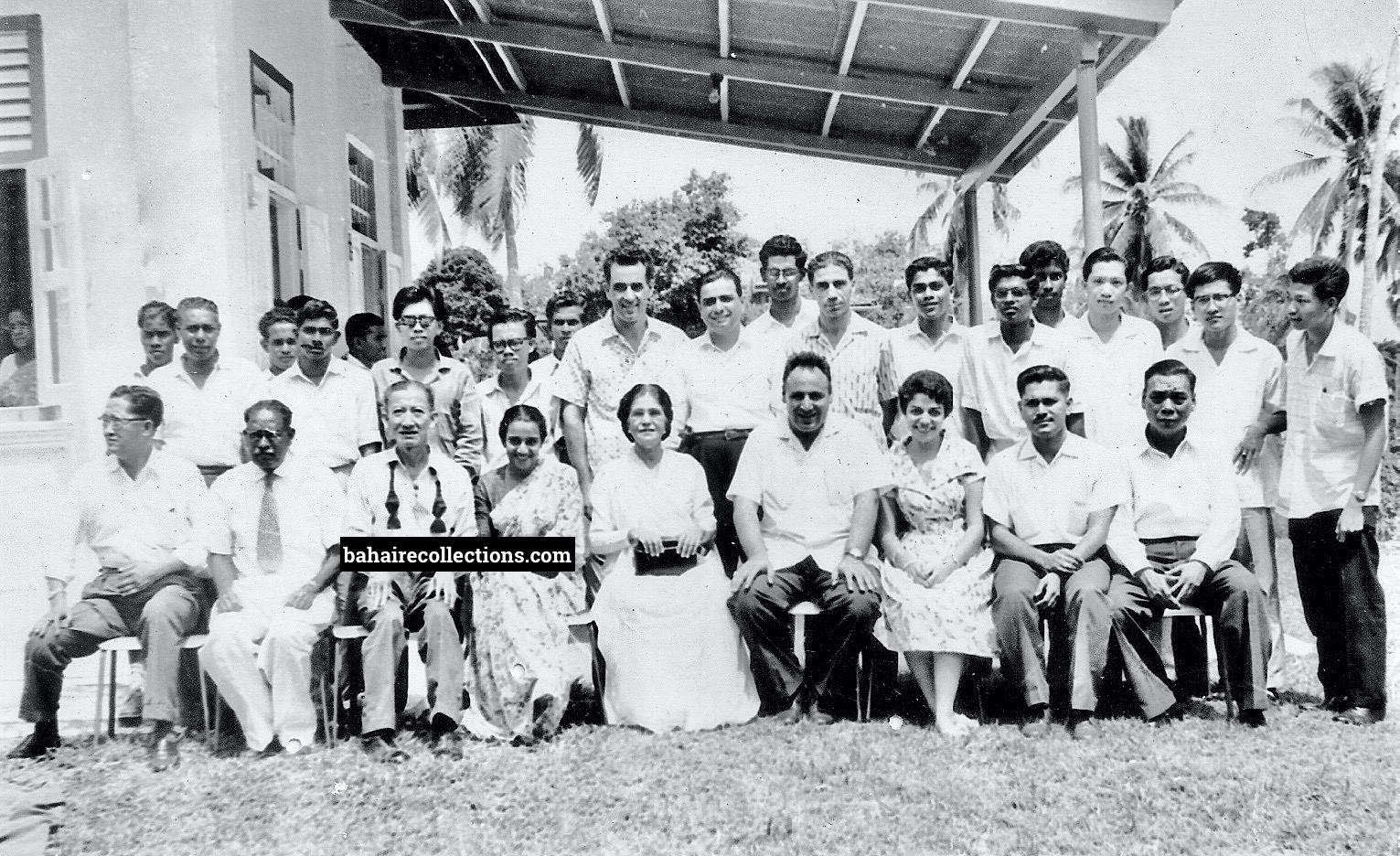
Summer School at Port Dickson, 1960. Seated L-R: Leong Tat Chee, K. Rajah, Yankee Leong, Shantha Sundram, Shirin Fozdar, Dr. Muhájir, Írán Muhájir, Jamshed Fozdar, Wong Kok Mee. Standing second from left is S. L. Thevar. Standing L-R: at the back of Shirin are Payman, Kishen Khemani, S. Bhaskaran, Eshraghian, and S. Satanam
Rajah played an important role as chairperson of a gathering held to honor the first public talk delivered by Hand of the Cause of God Mr. Collis Featherstone when he first came to Malaya. When Mr. Featherstone first came to Malaya in early 1960, there was an air of excitement and the organizing committee made every effort to make full use of his visit. On the evening of 5 October 1960, a Public Talk was arranged at the Kuala Lumpur Town Hall where Mr. Featherstone spoke on the topic of “Pattern for Tomorrow.” More than 60 people attended the talk, which was presided by Rajah.

At the Bahá’í Centre at 106, Birch Road in 1960. Mrs. Shirin Fozdar who has just returned from a world tour addresses the friends. Rajah is seated second from left. This was the Bahá’í Centre that was rented for weekly firesides and public gatherings. The Bahá’í Centre signboard is above the bookshelf, partly hidden.
Back in his home town of Seremban, the years 1960 and 1961 witnessed the coming into the Faith of some great souls. Following the acceptance of the Faith by S. Satanam, some ten of his classmates at the Anglo Chinese School accepted the Faith, including A. Sabapathy. Other youths who accepted the Faith around the same time were Jack Tan, Isaac DCruz, Pauline Yan, Nit Singam, K. Krishnan, and Annamalai. With a group of 16 vibrant youths, the Seremban Bahá’í Youth Section was formed in 1960, with S. Satanam as Chairman. Lily Ng too had accepted the Faith by this time. With this dynamic set of souls entering the Bahá’í fold, the community experienced a hive of activities as never before. Yankee Leong and Rajah were very proud of this development. The Local Spiritual Assembly of Seremban of 1961 took a different turn with membership by new blood with Rajah and Yankee Leong still serving with them. The new members on the Spiritual Assembly of 1961 were Poi Eng Siew, Lily Ng, Stevan, Nit Singam, S. Satanam, Annamalai, and R. Marriappan.
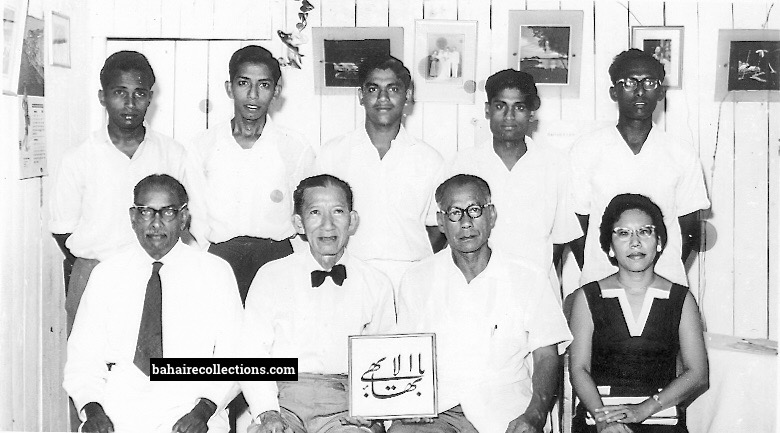
Local Spiritual Assembly of Seremban, 1962. Seated L-R: K. Rajah, Yankee Leong, Poh Eng Siew, Lily Ng. Standing L-R: Stevan, Nit Singam, S. Satanam, Annamalai, and R. Marriappan.
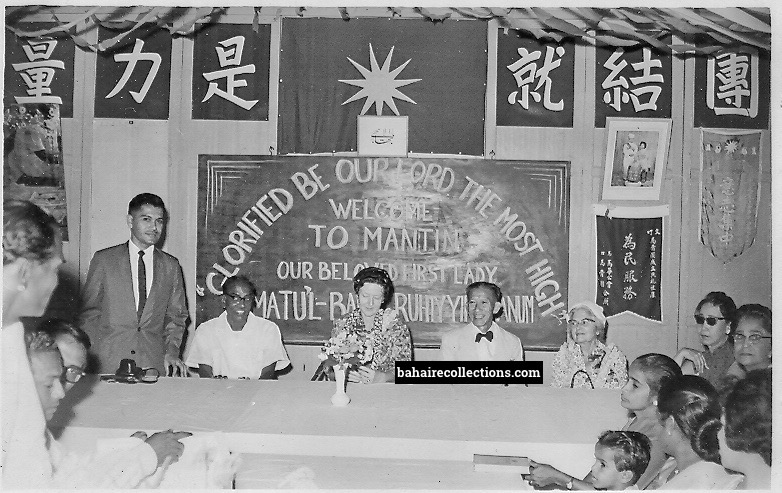
Amatu’l-Bahá Rúhíyyih Khánum meets friends at the Malayan Chinese Association Hall in Mantin, Negeri Sembilan, 1 September 1961 on her first visit to Malaya. From L-R: Jamshed Fozdar, K. Rajah, Amatu’l-Bahá, Yankee Leong, Miss Jessie Revell (Treasurer of the International Bahá’í Council), Mrs. George Lee, Mrs. Shirin Fozdar.
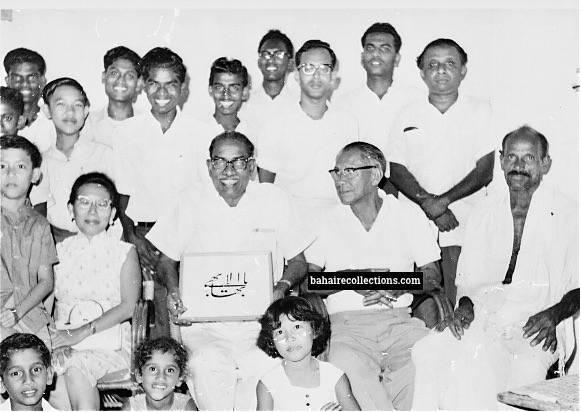
At a Nineteen Day Feast in Seremban in 1962. Seated L-R: Lily Ng, K. Rajah, Poh Eng Siew (unknown). Standing L-R: Krishnan Kandasamy, Annamalai, Vishnupatham. Standing in the center are R. Mariappan (L) and K. Krishnan (R).
Rajah not only served in Seremban but extended his assistance to other communities in the state of Negeri Sembilan. When the Bahá’ís of Seremban took an active role from 1960 onwards in the formation of a Local Spiritual Assembly in Port Dickson, Rajah travelled to deepen the friends there on Mondays, Wednesdays, and Fridays. In 1962 there were 32 believers in Port Dickson and an Assembly was formed. In the mid-1960s he was also assisting the Kuala Pilah community which saw a large number of people accepting the Cause.
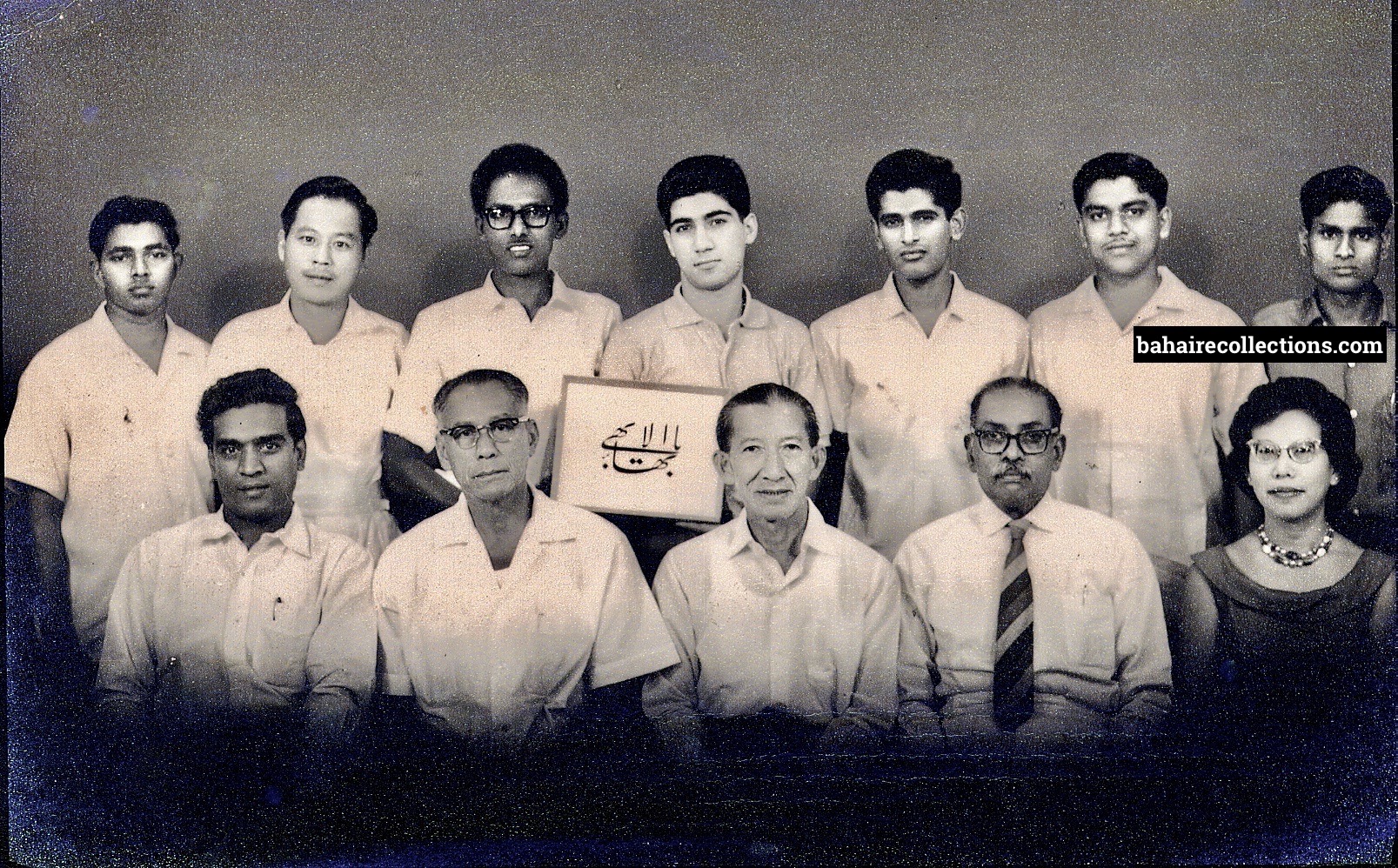 Group photo, January 1963 . Seated L-R: (Unknown) Poh Eng Siew, Yankee Leong, K. Rajah, Lily Ng. Standing L-R: A. Sabapathy, Lee Teck Seng, R. Mariappan, Bijan Bayzayee (Persian pioneer to Laos who passed through Malaya), Isaac DCruz, S. Satanam, Annamalai.
Group photo, January 1963 . Seated L-R: (Unknown) Poh Eng Siew, Yankee Leong, K. Rajah, Lily Ng. Standing L-R: A. Sabapathy, Lee Teck Seng, R. Mariappan, Bijan Bayzayee (Persian pioneer to Laos who passed through Malaya), Isaac DCruz, S. Satanam, Annamalai.

Local Spiritual Assembly of 1965. Seated L-R: Pauline DCruz, Poh Eng Siew, K. Rajah. Lily Ng. Standing L-R: R. Mariappan, Isaac DCruz, Vishnupatham, Lee Teck Seng, Jack Tan. Yankee Leong was on the National Spiritual Assembly in 1965, and in January 1966 he was appointed Auxiliary Board member for Asia with special reference to Sarawak and Brunei.
On account of his vast knowledge and experience in the Cause and life experience, Rajah was also tasked with some pivotal responsibilities. At the Bahá’í Summer School held in Port Dickson in 1960, Dr. Muhájir suggested the appointment of state representatives to open virgin areas in the country to the Faith. Yankee Leong and Rajah were appointed to cover the Seremban areas. In 1963 Rajah was appointed to the National Teaching Committee. In 1965 he was elected to the National Spiritual Assembly of Malaysia at the age of 67 and served on this institution until he left in 1974 at age 76. To date, Rajah has been the oldest member of the national institution at the time of his first election and his retirement.
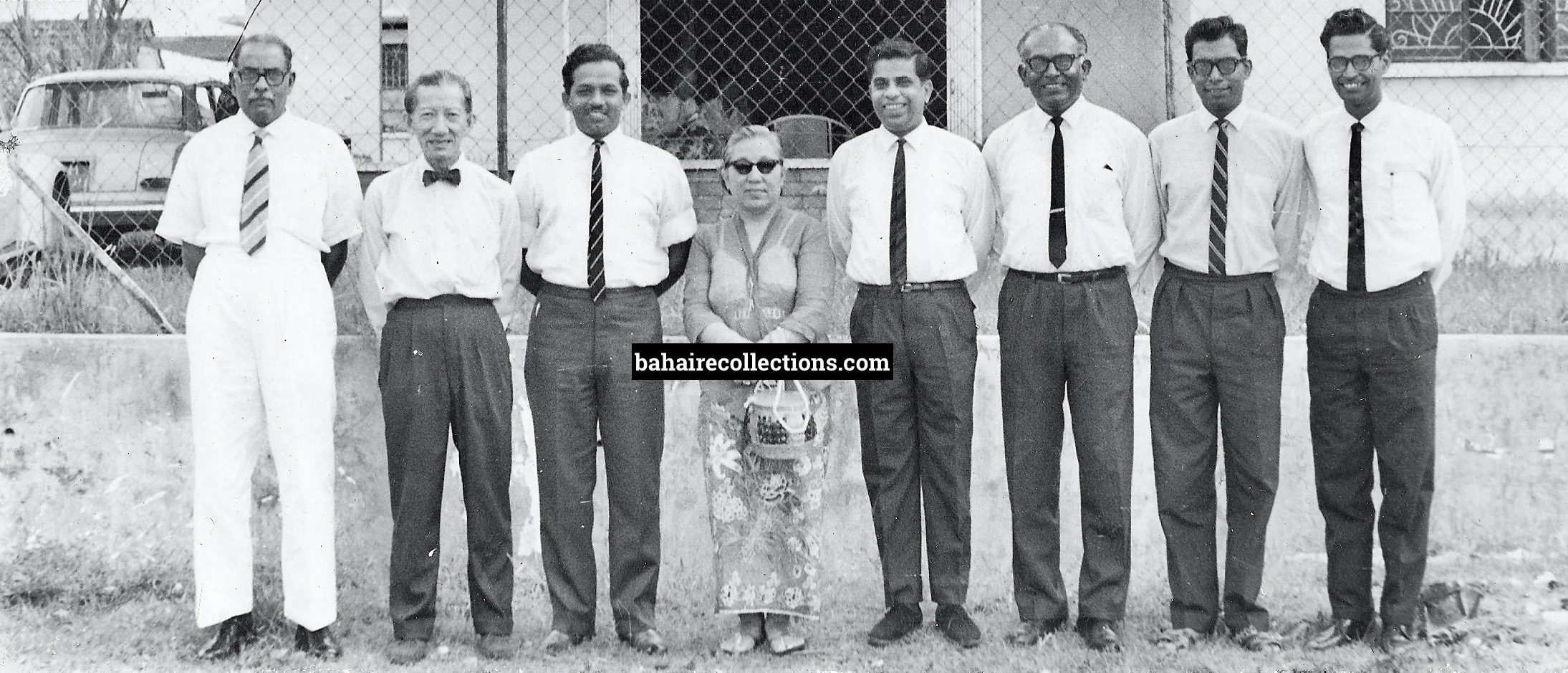
National Spiritual Assembly members of 1965, after holding their first meeting in the newly occupied National Bahá’í Centre at 32, Jalan Angsana,Kuala Lumpur, donated by Mrs. George Lee of Singapore. Standing L-R: K. Rajah, Yankee Leong, Tony Fernandez, Mrs. George Lee, Dr. Chellie Sundram, Appu Raman, Inbum Chinniah, S. Vasudevan. (Missing in the photo is Dr. John Fozdar).
Rajah was said to have contributed much to the deliberations of the national institution. Even while serving on the National Spiritual Assembly he was appointed to the editorial board of the Malaysian Bahá’í News Magazine in 1965, the Temple Site Committee and the Proclamation Committee in 1966, and the National Asli Teaching Committee in 1971. In all these committees he served with distinction.

Bahá’í Seminar in Singapore, December 1966. Seated L-R: Professor Nguyen Van Loi from Vietnam, Hand of the Cause of God Taráz’u’lláh Samandarí and K. Rajah. Standing L-R: M. Maniam, A. Sabapathy, Jami Subramaniam (unknown) G. Appala Naidu, Dr. Mehdi Samandarí (son of Mr. Samandarí) C. Subramaniam, Leong Tat Chee.
By 1966 Rajah was already like the rock of Gibraltar in the Faith and with his significant life experience combined with knowledge of the Faith, he would advise the next generation of believers. At the National Bahá’í Convention of 1966, he told the Bahá’ís to cut away from unwanted old traditions, if these traditions were found to be a hurdle to the service in the Cause. He used to say, “Once you are a Bahá’í you have to stop going to temple, not because we do not respect the temples, but others would not take the Bahá’í Faith and the Bahá’ís seriously.”
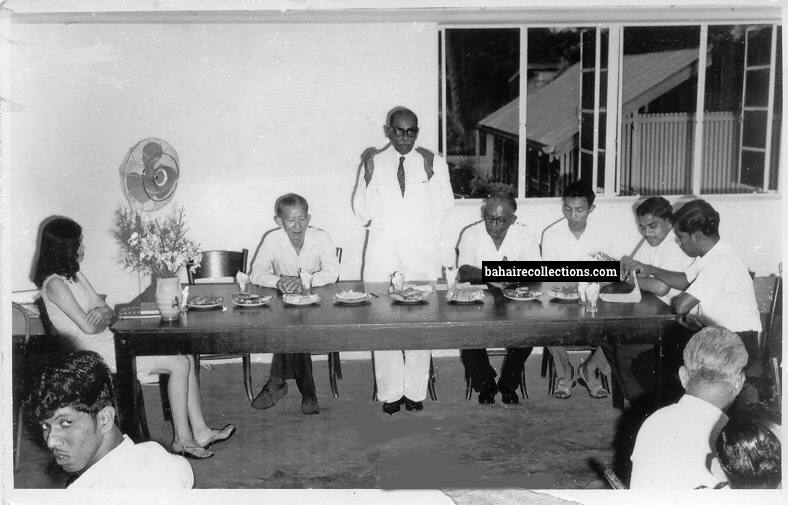
A gathering in an estate, 1967. From R-L: M. Maniam, S. Satanam, Choo Yeok Boon, Appu Raman, K. Rajah, Yankee Leong.
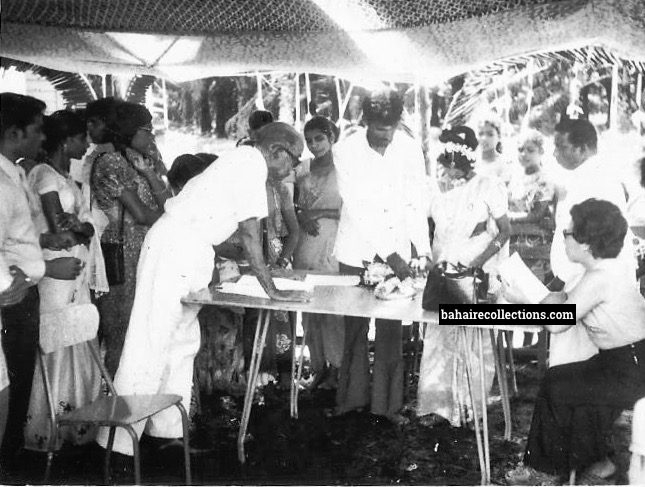
Rajah conducts the Bahá’í wedding of Mr. Jeffrey Bala in Ampar Tenang Estate, near Dengkil town. Seated at the extreme right is Lily Ng.
He would advise the youths. “This is the day of teaching to others what our Faith stands for by our deeds, not mere words. Deeds attract faster than words. Bahá’ís should certainly avoid alcohol. Smoking may be said to be discouraged in the Writings, but if you go deeper into the various passages you know what to do in so far as smoking is concerned.” On the organizing of financial means, he would advise, “After contributing to the Bahá’í fund, make it a point to save at least 10 percent of your earnings for your rainy days.” He also taught some eye exercises to those wearing glasses to keep the vision intact.
Rajah was not so much a field teacher, but he did not miss out on any opportunity to teach the Faith, including to his taxi drivers. When the taxi on which he traveled had already reached the destination, it was common to find that Rajah would stay in his seat for another ten or fifteen minutes, trying to conclude the conversation on the Faith he would have started during the journey. Whenever he arrived at the National Centre, such scenes would thrill the workers at the National Centre. They would whisper among themselves, “Rajah is back in his usual action!”
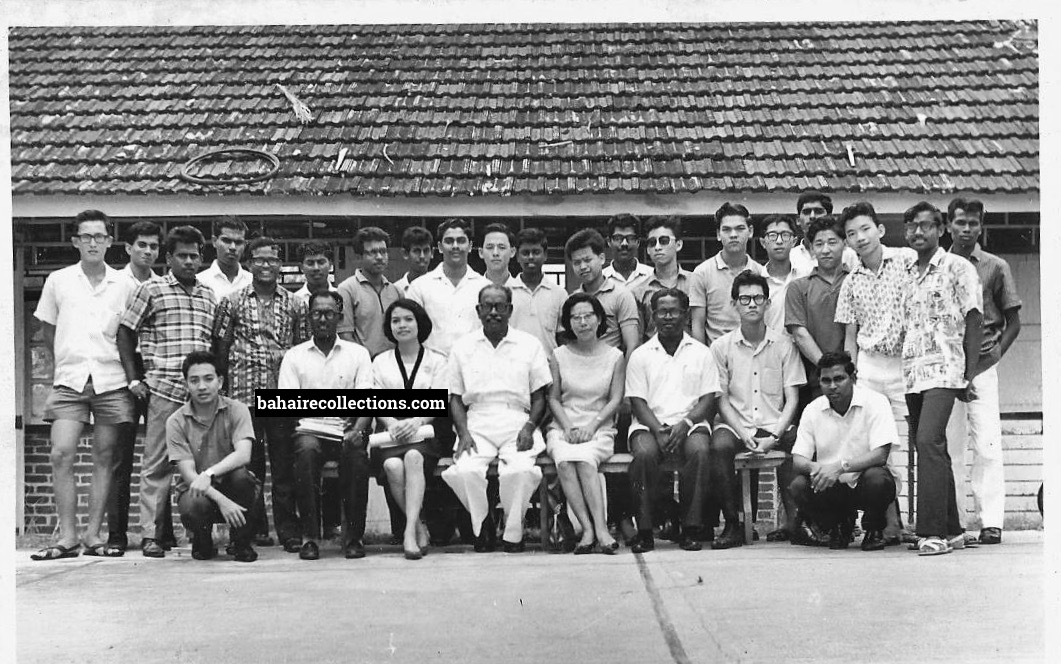
Gathering at the Sports Club of the Public Works Department of Kuala Pilah, February 1966. Seated L-R: R. Mariappan, Mary Tan, K. Rajah, Lily Ng, Stephen Manoharan, Alan Chai. Squatting at left is Jack Tan and at right is A. Sabapathy. At the back of Rajah in white is S. Satanam.
One of the areas that not many ventured into was giving the message to prominent national and international leaders. Here, Rajah played a significant role as he had experience in dealing with people of capacity. He would openly and courageously write to people of prominence both at home and abroad and introduce the Faith to them. At Bahá’í gatherings where he was asked to go on stage and give an update on who were the latest world leaders to whom he had written regarding the faith, he would share the list of names and people he had contacted. These included Prime Minister Winston Churchill of the United Kingdom, Prime Minister Indira Gandhi of India, and many leading officials, people of prominence, and organizations In that sense, he was one of the early initiators of external affairs activities in Malaysia. Noticing his audacity in bringing the Cause to those unimaginable heights, some friends urged Rajah to go slow as they were worried of possible opposition his letters may invite. Yet Rajah was as unrestrained as the wind where service was concerned, little fearing any opposition.
Rajah accepted the Faith at an older age, and driving was not easy for him. He usually traveled by bus for long distances and took taxis for shorter distances. When serving as Treasurer on the National Assembly, Inbum Chinniah, the Secretary would telephone Rajah and send contributions and letters to him through one of the staff of the National Bahá’í Centre, usually C. Kanagaratnam the Administrative Assistant who would travel by bus and deliver them in his home at 70 Hose Road in Seremban. Upon the arrival of the staff in his bungalow, Rajah would be ready with the signed checks and other replies. Rajah had an old Volkswagen car which he seldom used owing to his advanced age and it was other members of the National Spiritual Assembly who provided transport to attend meetings of the national institution, participation in National Conventions and Summer Schools, and other gatherings held in Port Dickson, some 18 miles away from Seremban town. Whenever he went to Kuala Lumpur for meetings of the national institution he would stay in the homes of Inbum Chinniah or Mrs. Gibson when they were on the national institution. Miss Kamachee, a Malaysia’s pioneer to Africa who stayed with the Gibsons observed that Rajah used to wake up very early at dawn to recite the Long Obligatory Prayer.
He was a well-sought after speaker at early Bahá’í conferences and Holy Days gatherings in Seremban and neighboring communities, and his talks were well-researched, informative, and charged. Among the memorable talks he gave were: The overall view of the Bahá’í Faith delivered at the Summer school in 1960; How the Bahá’í Faith can solve the world’s problems at the State Teaching Conference was held in Seremban in November 1963; an introduction to the Faith at the Naw-Rúz celebrations held on a grand scale in Kuala Pilah town in 1966; on Bahá’u’lláh at the Vivekananda Hall at Seremban on His Birth Anniversary 12 November 1967; “Obligations of a Bahá’í” at the Youth Convention for the Central Region was held in September 1970 in Kuala Lumpur. He felt no generation gap with the youth who would flock to listen to his talks. It was such fun to listen to Rajah giving advice in his Ceylonese Tamil to the Tamil speaking believers.
Rajah’s presence at gatherings was always visibly felt as he would always appear in full white attire, often with a necktie. He was a product of British Malaya where the employees used to be attired in white. And Rajah carried this tradition right to his last days. Rajah also proved to be youthful at times. At the Summer School of August 1971 held in Port Dickson, the spirit was so high that the conservative Rajah burst out singing the “I Love You” song – at the advanced age of 73, winning applause from all.
In Ridván 1972, the National Spiritual Assembly of East Malaysia and Brunei was formed. The occasion was graced by the presence of the Hand of the Cause of God Jalal Khazeh from the Holy Land. Also present was Counselor Dr. Chellie. J. Sundram, while S. Nagaratnam and Rajah represented the National Spiritual Assembly of West Malaysia. Rajah also represented the Local Spiritual Assembly of Seremban at the official opening of the new mosque in Seremban in 1967 as he was highly regarded in the government circles. In that sense, he was one of the early initiators of external affairs activities in Seremban.
Rajah was one of those pioneers in producing local Bahá’í literature at a time when there were few reading materials available. In 1967 he came out with a book entitled “God is the All-Knowing Power of the Universe.” He also wrote a book called “Creative Power Behind All Existence” When Hand of the Cause of God God Abu’l-Qásim Faizi came to Malaysia for a conference in 1968 he read this book and commented, “Rajah now writes with full conviction what he had been speaking of before.” In 1975, Rajah again wrote a book called “Poverty to Plenty” with an introduction by the famous Bahá’í writer Stanwood Cobb. The other books by Rajah were “Know Why You Are Living On This Earth,” “Work For All, A Challenge To Our Society” and “Conflicts In Values, Peace or War.” Thus, in his own small way, Rajah had contributed to enriching the Bahá’í literature in the early days.
He was on the National Spiritual Assembly from 1965 (Vice-Chairman), and its Treasurer from 1967 to 1972. In 1973, N. Sivasathiaseelan Nadarajah (N. S. S. Silan) became the National Treasurer to whom Rajah passed on the handover notes and other documents. After going through the well-kept records that Rajah had produced, Silan remarked that the financial ledgers were well maintained and that Rajah had indeed set a high standard of financial records maintenance with all supporting vouchers and documents. Rajah was last on the National Spiritual Assembly for the term 1973 to 1974.

National Spiritual Assembly of 1973. Seated L-R: Yin Hong Shuen, Ganasa Murthi, Shantha Sundram. Standing L-R: A. P. Arumugam, K. Rajah, S. Nagaratnam, Dr. M. M. Sreenivasan, Isaac DCruz, Dr. M. Singaraveloo.
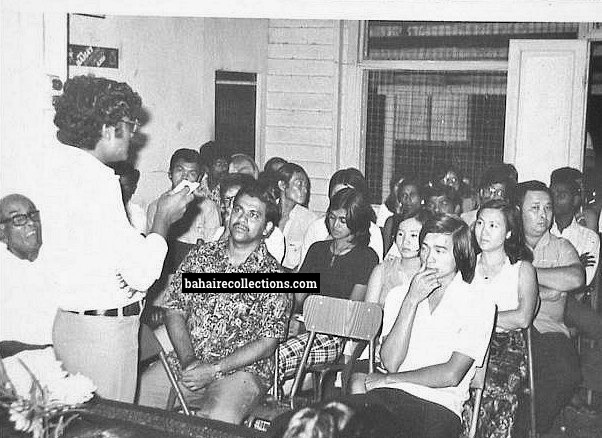
Rajah at the left listening to a talk by the author at the Seremban Bahá’í Centre, 1976. In the center is S. Satanam and at the extreme left is Giam Chin Chye. Seated in the back row with folded arms is Mr. Lee Swee Leong while Sobhana Kumaran in the black outfit.
Following his advanced age and ill health, Rajah could no longer attend Bahá’í meetings. But he would with difficulty visit the Seremban Bahá’í Centre as his heart was always with the Bahá’í Centre. He was always hungry for news of Bahá’í activities. Satanam made it his duty to visit Rajah often in his house to keep him informed of the growth of the Faith and bring him to the Bahá’í Centre. In the later part of the 1970s he slowed down further, and his daughter Thavamany and relatives would drop him at the Bahá’í Centre and transport him back after the meetings were over. Some Bahá’ís too would provide transport for him to come to some events held in Port Dickson. He entered the Faith at the age of 56 and had done his utmost within his strength until he was no longer able to serve actively.
Although Rajah did give the Faith to all his family members, it was only his son Vijayasingam who accepted the Faith in 1970 when he went over to Christchurch in New Zealand to take up university studies. He was actively involved in teaching activities in the local community. Towards the evening of his life, Rajah had been talking to S. Satanam of his desire to donate a portion of his property to the Cause, but that did not materialize as he had slipped into ill health to proceed on that arrangement.
After a prolonged period of illness for many years, he finally passed away on Sunday, 20 December 1992 at the age of 94 in Seremban and was given a befitting Bahá’í burial at the Seremban Bahá’í burial ground. S. Satanam ensured that all arrangements for the funeral went well. After listening to glowing tributes paid by the Bahá’ís, Mr. Kulasingam, the eldest son of Rajah, broke into tears and thanked the community for the love and affection shown him. His parting words were, “I never knew my father had done so much for the Bahá’í Faith and had touched so many hearts. Today I feel prouder than I ever before to be his son.”
Thus, ended the life of a person who accepted the Faith at an advanced age and served the Faith in various capacities with amazing zeal, driving force, and distinction. His life became an excellent example of how age is no barrier to serving the Cause. In hindsight one would conclude that Rajah was chosen for the pivotal roles he performed with distinction and thus won for himself the crown of distinguished service to the Malaysian Bahá’í Community. No keen and honest observer of history can truthfully ignore that an ordinary man, Rajah Kathirvelu, has become a truly legendary figure in the annals of our Faith.
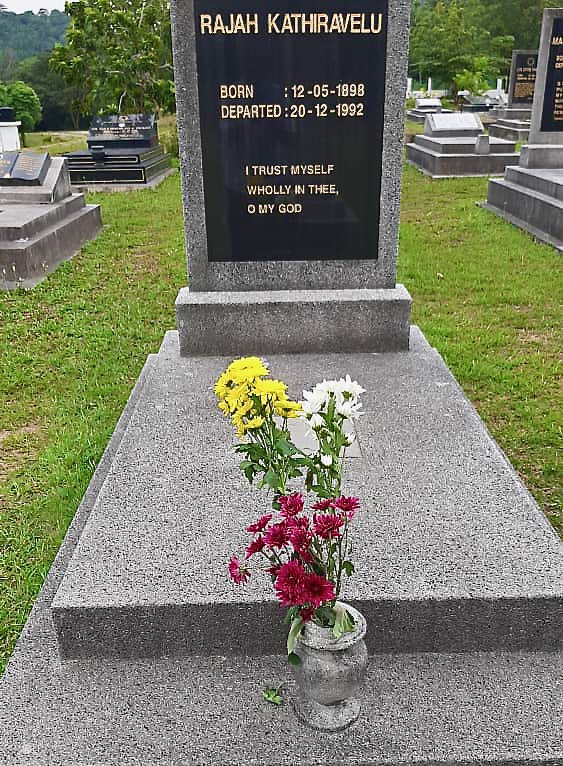
A truly legendary figure in the annals of our Faith.
A. Manisegaran
31 December 2020
copyright@bahairecollections.com